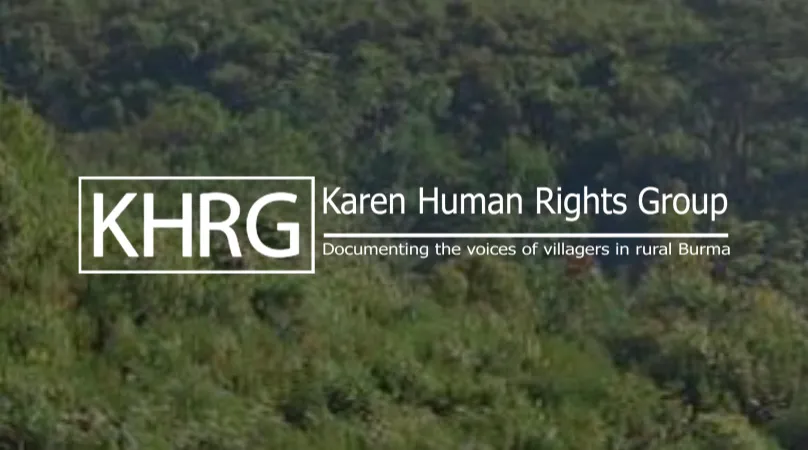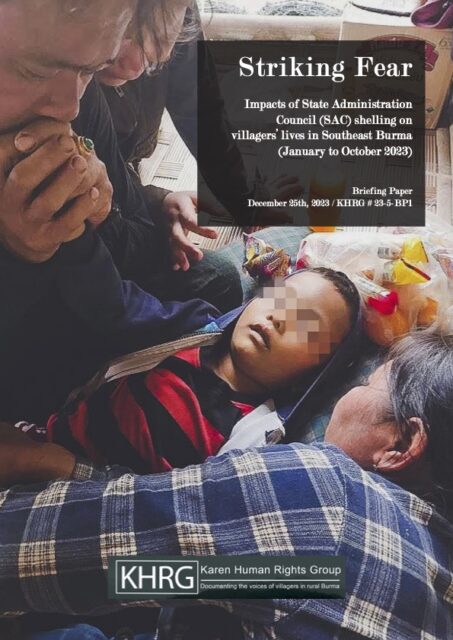Striking Fear: Impacts of State Administration Council (SAC) shelling on villagers’ lives in Southeast Burma (January to October 2023)
25 December 2023


Introduction
The villagers in Southeast Burma (Myanmar)[1] have been facing conflict for as long as they can remember. Generations have grown up amidst the fighting, and have lived their whole lives under a fear of attacks. The 2021 coup[2] reinvigorated the open and direct violence of the Burma Army[3], under the command of the State Administration Council (SAC)[4], in locally-defined Karen State[5]. These attacks are deliberately directed towards civilian areas and communities, including by indiscriminately shelling villages and plantations. From January to October 2023 alone, KHRG recorded more than 192 incidents of indiscriminate shelling committed by the SAC, which killed and wounded villagers, destroyed civilian houses, buildings, and plantations, affected livelihoods, and caused displacement.
This briefing paper investigates the consequences of SAC shelling in civilian areas and its impacts on the lives of rural villagers in Southeast Burma. The first section gives an overview of the history of violence and oppression in the region by the Burma Army. The second section presents the immediate consequences of shelling on villagers, including deaths and injuries, the destruction of property, and livelihoods harmed. The third section analyses longer-term impacts, including displacement, persistent fear among villagers, restricted access to education, and the heightened risk of unexploded ordnance (UXOs). Finally, a security and legal analysis of the current situation is conducted, and recommendations addressed to relevant stakeholders are presented.
1. Contextual overview
Locally-defined Karen State has been in ceaseless civil conflict since Burma’s independence in 1948. Since then, the Karen people have been targeted by the Burma Army, who have persecuted and oppressed ethnic minorities around the country and sought to impose military dictatorship. The armed conflict intensified in the early 1990s when the Burma Army, after the nationwide 1988 civilian uprising against military rule, launched an assault that ended in the fall of the city of Manerplaw, the former seat of the Karen National Union (KNU)[6] and Karen National Liberation Army (KNLA)[7]. Whilst the 2015 ceasefire agreement brought hopes for peace, Burma Army violence persisted and villagers in Karen State continued to experience oppression, exploitation of resources and cultural persecution.[8] The failed hopes of the ceasefire were compounded when the Burma Army staged a coup against the democratically elected civilian government in February 2021. Since then, as ethnic armed groups and People’s Defence Forces (PDFs)[9] fight the SAC and other affiliated armed groups, civilians in Karen State continue to live in open military conflict.
Throughout this conflict, the Burma Army has frequently conducted indiscriminate shelling into civilian areas to target villagers as part of their “four cuts” strategy to cut ethnic armed groups off from food, funds, recruits and intelligence. The systematic targeting of civilians is sometimes motivated by aims to damage armed resistance forces or punish civilians for supposedly supporting them.[10] Villagers are also targeted arbitrarily and indiscriminately, often with no clear strategic motive. The Burma military’s counter-insurgency operations have involved extrajudicial killings, torture, arbitrary arrests, forced displacements, looting and extortion, sexual violence, forced labour, and since 2021, air strikes. As the level of violence is high and organised armed actors are involved, customary international humanitarian law of non-international armed conflicts applies and has been violated, amounting to war crimes. Furthermore, since widespread and systematic attacks against civilians are being committed, the abuses by the Burma Army amount to crimes against humanity under customary international criminal law, as well as human rights violations.[11]
Announcements
28 February 2025
Asian NGO Network on National Human Rights Institutions , CSO Working Group on Independent National Human Rights Institution (Burma/Myanmar)
Open letter: Removal of the membership of the dis-accredited Myanmar National Human Rights Commission from the Southeast Asia National Human Rights Institution Forum

Progressive Voice is a participatory rights-based policy research and advocacy organization rooted in civil society, that maintains strong networks and relationships with grassroots organizations and community-based organizations throughout Myanmar. It acts as a bridge to the international community and international policymakers by amplifying voices from the ground, and advocating for a rights-based policy narrative.